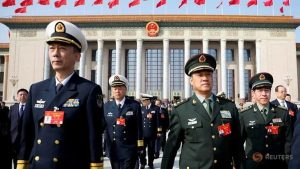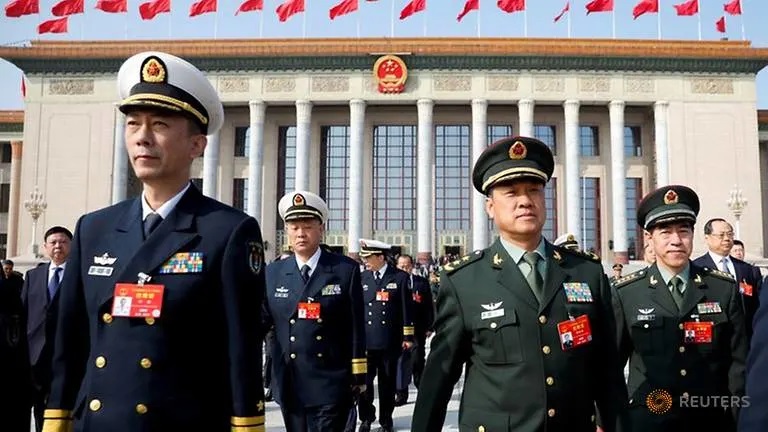
Military delegates leave the Great Hall of the People after a meeting ahead of National People’s Congress (NPC), China’s annual session of parliament, in Beijing, China, on Mar 4, 2019.
Military delegates leave the Great Hall of the People after a meeting ahead of National People’s Congress (NPC), China’s annual session of parliament, in Beijing, China, on Mar 4, 2019.
BEIJING: China’s defence spending this year will rise 6.6 per cent from 2019, according to a report issued at the opening of the country’s annual meeting of parliament on Friday (May 22), a slower rate than last year.
The figure, set at 1.268 trillion yuan (US$178.16 billion), is closely watched as a barometer of how aggressively the country will beef up its military capabilities.
China set a 7.5 per cent rise for the defence budget in 2019, outpacing what ended up as full-year gross domestic product growth of 6.1 per cent in the world’s second-largest economy.
China’s economy shrank 6.8 per cent in the first quarter of 2020 compared with a year earlier, as the novel coronavirus spread from the central city of Wuhan, where it emerged late last year.
China omitted a 2020 economic growth target for the first time and pledged government support for the economy in Premier Li Keqiang’s work report on Friday, launching the country’s annual parliament meeting.
STRATEGIC COMPETITION
Despite the coronavirus outbreak, the armed forces of China and the United States have remained active in the disputed South China Sea and around Chinese-claimed Taiwan.
The coronavirus has worsened already-poor ties between Beijing and Washington.
The Ministry of State Security warned in a recent internal report that China faced a rising wave of hostility in the wake of the coronavirus outbreak that could tip relations with the US into armed confrontation.
China routinely says that spending is for defensive purposes, that it is a comparatively low percentage of its GDP, and that critics just want to keep the country down.
China reports only a raw figure for military expenditure, with no breakdown. It is widely believed by diplomats and foreign experts to under-report the real number.
Taking the reported figure at face value, China’s defence budget in 2020 is about a quarter of the US defence budget last year, which stood at US$686 billion.
China has long argued that it needs much more investment to close the gap with the US. China, for example, has only two aircraft carriers, compared with 12 for the US.
In 2018, China announced its largest military budget increase in three years at 8.1 per cent, to 1.1 trillion yuan.
But growth in defence spending has slowed since, with China and the US embroiled in a bitter trade war that has put pressure on the domestic economy, now further battered by the coronavirus pandemic.
“As China’s economic growth slows, its no surprise that military spending growth will also come down,” said Adam Ni, an expert on China’s military modernisation at Macquarie University in Sydney.
He pointed out that despite mounting tensions with the US, “defence spending has not risen sharply”.
The People’s Liberation Army (PLA) reached two major milestones last year, unveiling both China’s first homegrown aircraft carrier and its first intercontinental ballistic missile capable of reaching the US.
China also built its first overseas military base in Djibouti, on the Horn of Africa, in 2017.
Beijing is designing a new generation of destroyers and missiles to strengthen its deterrent against Asian neighbours and the US navy.
“The PLA has achieved great strides in terms of long-range artillery, electronic warfare and cyber capabilities, and also improved on its maritime and aerospace operations,” said James Char, a military expert at the Nanyang Technological University.
“But if we compare it with other advanced militaries, the PLA still lags behind due to its limited experience in conducting combined arms operations and joint operations at battalion level.”
Experts pointed out that increasing defence spending could also give the economy a much-needed shot in the arm, with manufacturing struggling and domestic consumption slack over worries about job security.



